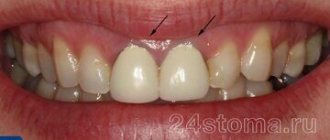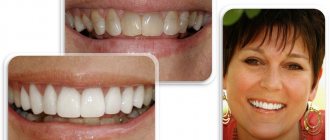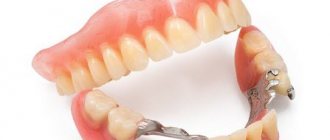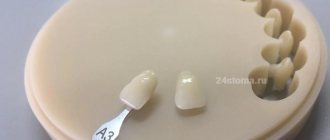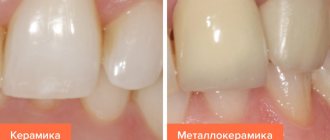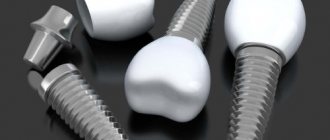Decay and loss of teeth are always associated with a number of problems. An ugly smile causes a bad mood, and digestive problems lead to disruption of the usual rhythm of life. Fortunately, modern dentistry has effective methods for restoring teeth. And the materials used for prosthetics are becoming more and more advanced every year.
Which teeth are better - metal-ceramics or metal-plastic?
For these purposes, ceramics, metal, plastic, and their compounds are now used. Let's look at the features of this or that material and try to answer the question of which one should be preferred.
Types of dental crowns
Metal ceramics
In dental prosthetics, metal-ceramics refers to bridges or crowns made from these materials. If only part of the tooth is damaged, then crowns are installed. When one or more teeth are completely missing, a bridge is made. And if there is only a tooth root, it is possible to install a metal-ceramic crown on a pin.
Dental prosthetics with metal-ceramics are most typical for the masticatory region
The orthopedic structure is made of metal in the shape of a tooth, which is covered with a layer of ceramics. Ceramics are applied to a metal base using one of the following methods:
- casting;
- spraying
In dentistry, when creating metal-ceramic prostheses, hypoallergenic materials are used that have good compatibility with the human body. And only in rare cases can individual intolerance occur.
Metal-ceramic crowns - photo
On a note! Most often, metal-ceramic dentures are installed in the area of chewing teeth, for which appearance is not particularly important, but it is extremely necessary to restore the ability to chew food normally.
To make the frame of a metal-ceramic prosthesis, dentists use the following types of metals:
- precious;
- semi-precious;
- simple.
A ceramic layer is applied to this base using one of the above methods. To make crowns, a composition specially developed for dental purposes is used. It has hypoallergenic properties, does not fade over time and does not change color. This material imitates tooth enamel well, repeating its color and structure. If in any particular case it is impossible to install a fixed prosthesis, then a removable metal-ceramic structure is used. It consists of a metal arch with metal crowns attached to it.
Ready-made metal-ceramic prosthesis
On a note! Despite the fact that the ceramic layer on dentures perfectly imitates tooth enamel, the metal base often shines through it.
If crowns are installed in place of chewing teeth, this is not critical. But when prosthetics are performed on the front teeth, it is necessary to resort to other materials in order to avoid this effect. In this case, as a rule, solid ceramics are used, but a base of zirconium dioxide or oxide can also be used.
Metal ceramics on the front teeth
Table. Metal-ceramic dentures - indications and contraindications.
| Name | Short description |
| Indications for installation of metal-ceramic prostheses | Loss of teeth. Tooth decay that precludes the use of inlays or veneers. Periodontal disease. Abnormal tooth structure that cannot be corrected by other means. High abrasion of teeth. When splinting teeth. |
| Contraindications | Individual intolerance. The last stages of periodontal disease. Complex bite pathologies. Small incisors on the bottom row. |
Metal-ceramic teeth
Video - Metal-ceramic bridge
Plastic as an option for prosthetics
It is most often used for the anterior teeth and also for the upper premolars . Recently, very often plastic crowns are used as temporary ones. This is a mandatory stage for proper prosthetics, at which another component can subsequently be installed.
But some patients opt for the plastic option because they are satisfied with the appearance and cost of the finished structure. This option has some deviations due to the fact that it is not suitable for many people. Plastic cannot be installed for those citizens who have periodontal diseases. Over time, the plastic will simply begin to absorb plaque . If you choose the right color, you can see clear advantages over other options.
In addition, for a low cost, you will carry out all the procedures immediately. But we should talk about the disadvantages. The crown manufacturing technology will involve extensive processing of hard tissue. The walls must be much thicker than metal so that the crown structure does not fall apart after a few months.
Pros and cons of metal ceramics
The following advantages of metal-ceramic prostheses are highlighted:
- aesthetic appearance - they practically do not differ in appearance from real teeth (the selection of a suitable shade is carried out from a large palette of ceramic coating colors);
- biocompatibility with oral tissues, as well as hypoallergenicity (in extremely rare cases, individual intolerance was observed);
- complete restoration of chewing function : metal-ceramic dentures are practically no different from living teeth in functionality and do not cause discomfort;
- reliability and durability : metal ceramics can withstand the stress of chewing food, are not subject to cracks, chips and deformation, and can last more than 10 years;
- hygiene : does not lead to the growth of bacteria in the oral cavity;
- Resistant to staining due to food dyes - no need to avoid eating any foods;
- Preservation of the tooth from further destruction due to its tight fit.
Metal ceramics - before and after
The disadvantages of metal-ceramic prostheses include:
- turning - requires removal of a significant part of the tooth tissue;
- depulpation - the nerves of the tooth are also removed when installing metal ceramics;
- wear of the contact surface of living teeth adjacent to the prosthesis.
Metal ceramics on implants
Video - Which is better, ceramics or cermets
Metal-plastic
Like metal-ceramics, metal-plastic prostheses consist of a metal frame and coating. The only difference is in the material from which the top layer is made. For this purpose, high-strength dental plastic is used, which is characterized by non-toxicity, a strong connection with the metal, and the ability to well imitate the surface of the tooth.
Plastic crowns
Such prostheses are installed in the following situations:
- as temporary structures designed to replace missing teeth while metal-ceramic dentures are being manufactured;
- as an external coating for implants with a metal base;
- when combining several types of prosthetics to restore the dentition;
- for prosthetics of individual front or chewing teeth.
Metal-plastic cast crowns
Types of dental crowns: which ones are better?
Dental clinics use many crowns for different clinical cases. How do they differ from each other and how important are these differences for the patient? How to choose a prosthesis with optimal aesthetics and functionality among such a variety?
